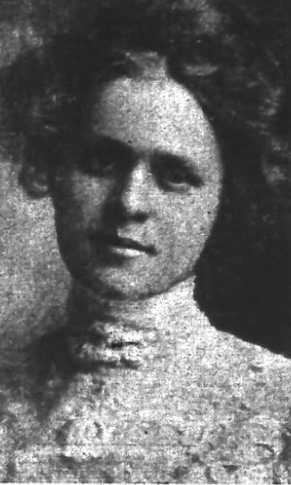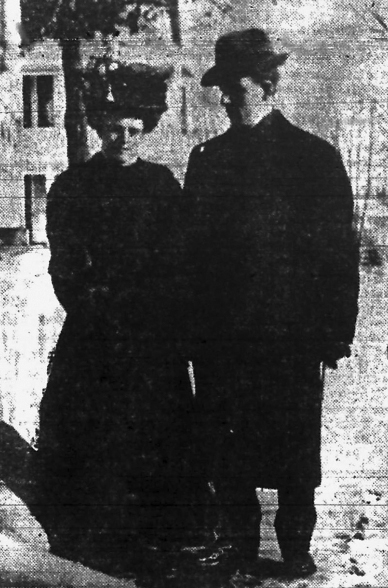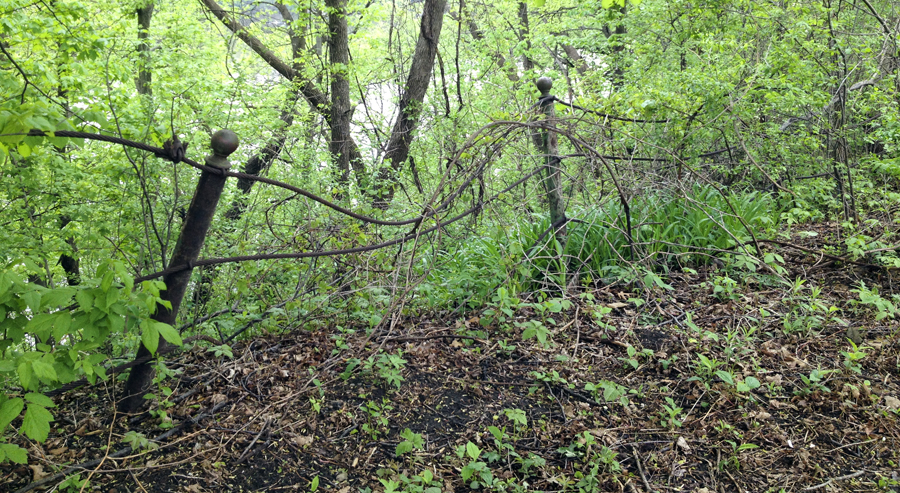Mary Fridley: An Inconvenient Wife
You may remember the name Fridley because you’ve passed through the northern suburb of Minneapolis while driving along 694, or recognize it as the home to the corporate behemoth Medtronic. But, as with most cities in Minnesota, there is a pioneer family behind the name. And, as with many pioneer families, if you dig deep enough there is a good chance you’ll uncover secrets, wrong-doing, or tragedy. The Fridley family was victim to the worst tragedy–murder.
Mary Fridley was the granddaughter of Abram and Betsey Fridley. Abram was a Winnebago Indian agent, lawyer, Minnesota territorial and state legislator, farmer, merchant, and land agent of the St. Paul and Pacific Railroad Company. Holding both wealth and power, the town of Manomin was newly named Fridley Township in 1879 to honor the first territorial representative for the area. Mary’s father, David, was a grocer and landowner in what now comprises the cities of Fridley, Columbia Heights, Hilltop, Spring Lake Park, and part of Northeast Minneapolis. Mary was raised with wealth and refinement but lacked the physical qualities that would land her a husband at what was considered to be an acceptable age. She was often referred to as being slight, pale, and boring, but managed to hold a job as a teacher at Adams School for several years. When traveling salesman Frederick T. Price entered the picture, Mary was perhaps too eager to overlook his two previous marriages and criminal past for love and attention. In 1907, at the age of 28, Mary and Fred were married and set up in Mary’s spacious apartment on Knox Avenue in north Minneapolis.


David Fridley, Mary’s father, had a reputation for being very frugal with his money. He chose to invest in land and real estate knowing the dividends would pay out in the long term more than stocks and business investments. David often gave his daughters, Mary and Louise, expensive gifts such as diamond jewelry, land, and cash. However, they would not inherit the bulk of the Fridley estate until David died. Fred was never able to give Mary gifts that compared to those of her father and quickly became resentful of Mary’s family money. He felt he shouldn’t have to work every day to meet their household expenses. Although Fred had access to some of Mary’s cash, she mostly kept it hidden away in two separate savings accounts and a safe-deposit box in her name alone. David suspected that Fred only married Mary for her family’s wealth and advised Mary to stay prudent with her money.
Soon, Mary was covering all of their living expenses out of her accounts while Fred was working to keep his eager young mistress, Carrie Olson, in fine clothing and expensive trips abroad. He knew keeping the endearments of an attractive girl were not cheap. By the summer of 1914, Fred was living well beyond his means and becoming increasingly interested in getting his hands on a substantial amount of Fridley money. He hinted to his friend and business associate Charles D. Etchison of a plan to “press out” David, Louise, and Mary in order to get the money he felt would be rightfully his.
In November of 1914, David explained to Mary that he was going to soon give her a gift of $10,000 cash and some railroad bonds and that she should make arrangements with her bank to access her safe-deposit box as soon as the gift came through. Mary was interested in using the money to establish a home for either aged women or children. She met with her sister Louise’s husband, William M. Dye, to inquire about the steps involved in getting the project off the ground. On November 28, 1914, the day after David’s gift came though, Fred and Mary quarreled fiercely about the money over breakfast. Having plans to attend a matinee performance of The Prince of Pilsen at the Metropolitan Theater with Fred’s friend Charles, the trio ate lunch at the couple’s apartment before heading out. After the performance, Mary said she’d like to air-out her little dog, Chum, and go for a drive. Fred suggested they visit St. Paul to look for new curtains for their apartment. After picking up Chum at the apartment, and with Charles in tow, they crossed the Mississippi River on the Franklin Street Bridge and headed south on Mississippi River Boulevard.
As they neared the Town and Country Club, Fred announced that the car’s engine wasn’t working right and pulled over so he and Charles could tinker with it before continuing on. After asking if they would be there a while, Mary and Chum got out of the car and started walking along the side of the road. A few moments later, the two men heard Mary yelling for Fred. Both men abandoned the car to find Mary and see what had happened. With a dark dusk settling in, they found her lying at the base of a steep bluff, moaning and crying for help. They quickly scrambled down to her. Fred went to her side and assessed her injuries while Charles stayed a modest distance away. Fred asked Charles to go back to the road and flag down some help, and then take his car to pick up either David or Louise and bring them to the hospital. Charles, with the help of a passing motorist, made a call for a doctor and ambulance and quickly left in Fred’s car. Hearing the commotion, passersby scaled the bluff and carried Mary back up to the road where a doctor was waiting to examine her. Mary had not broken her neck but had a large indentation–four- by five-inches in size–on the left side of her head. The doctor told Fred there was nothing he could do for her until they got to the hospital, but admitted that she may not live that long.

Against the doctor’s wishes, Fred insisted on riding in the ambulance with Mary to the hospital. During the ride, Fred repeatedly shook Mary’s small, unconscious body violently and yelled: “Mary, speak to me!” Nearing the hospital, the doctor observed Fred resting his hand on Mary’s forehead and pressing his forearm over her nose and mouth, after which the doctor threatened to toss him from the ambulance if he didn’t stay away from her. Mary died just before arriving at the hospital.
At the hospital, Fred and Charles told the examining surgeon and police what transpired earlier in the evening. The doctors could not understand how Mary could have sustained such a traumatic head injury without breaking her neck, suffering any heavy bruising on her body, or torn her clothing in such a fall. However, the police seemed to buy the story and simply filed an accident report. After Louise and her husband arrived at the hospital and were told the same rendition of the accident, they also raised concerns about the story by asking questions that Fred wasn’t able to answer. Fed up with the skeptics, Fred growled, “Someday you’ll try to make trouble for me over this.” He retreated to his car and drove to Carrie Olson’s apartment to spend the night with her. He told her he’d just found out his wife had been killed in an automobile accident in California, so they could soon be married.
Mary was laid to rest under the Fridley monument at Lakewood Cemetery in Minneapolis. She’d left an estate worth over $25,000 (equal to about $600,000 today), which under Minnesota law would pass to her husband since she didn’t have a will and the couple had no children. By the first week of December, Fred moved to have himself appointed as the administrator of her accounts. After finding out the process could take some time, Fred begged the bank to front him some cash to “settle her affairs.” Playing the grieving widower paid off for him, the bank agreed to give him $500, which would be deducted from Mary’s estate when it was paid out. The next day, Fred and Carrie moved into a brand new apartment in Minneapolis, happily telling the landlord they were newlyweds. David Fridley covered all of Mary’s hospital, funeral, and burial expenses.

On December 28, 1914, Fred became the full administrator of Mary’s estate. He promptly transferred all of Mary’s land holdings to his sister in Wisconsin, and all of her cash and securities to himself. Out of this cash, he paid Charles Etchison $7,000 on December 30, 1914, $1,500 in April 1915, and $1,150 in June 1915. Using more of Mary’s money, Fred, Carrie, and Charles took a first-class trip to Kansas City in June and July of 1915, where Fred and Carrie were married in a civil ceremony, with Charles as a witness, on July 12th.
In October 1915, Fred hatched a plan to file a civil lawsuit for $7,500 against the Minneapolis Park Board alleging negligence in failing to erect a guardrail where Mary had fallen. The case went to trial. Fred and Charles repeated the story they gave in the past to the jury. Later in the day, a park board expert testified that after he’d made a thorough investigation of the area. He concluded that in order for Mary’s body to have been found where she was, 42-feet below and 27-feet beyond the outermost cliff, there would have to be some sort of propulsion behind her fall to get her tiny body to where she was found. After this testimony, Fred abruptly dropped the lawsuit and left for Philadelphia.
After the testimony was presented, Mary’s father quietly hired a former police detective and family friend, Detective Hoy, to look into the matter further. He was also instructed to look into Fred’s background. Detective Hoy found the secret that would be Fred’s undoing. In 1896 Fred had married Miss Rose Smith in Wheaton, Illinois. Rose and Fred separated in 1901 but were never divorced. However, in 1903 Fred illegally married Miss Grace Schwartz in Rockford, Illinois. She cited cruel and inhuman treatment and alleged abuse before being granted a divorce two years later. Fred went on to illegally marry Mary in 1907 and Carrie in 1915. Armed with this evidence, and in-depth investigative evidence about Mary’s death, David Fridley asked his lawyer to press a Grand Jury to convene in Hennepin County on November 18, 1915, to hear the evidence and visit the place of Mary’s death. That next day, Fred Price and Charles Etichison were indicted on first-degree murder charges. At the same time, David asked the probate court to revoke the decree naming Fred as the administrator of Mary’s estate. The probate court agreed that he was not entitled to her property since they were not legally married. David sent his investigator to recover all of Mary’s assets that had not yet been squandered.

In 1896, Fred married Miss Rose Smith in Wheaton, Illinois. Rose and Fred separated in 1901 but were never divorced. However, in 1903 Fred illegally married Miss Grace Schwartz in Rockford, Illinois. She cited cruel and inhuman treatment and alleged abuse before being granted a divorce two years later. Fred went on to illegally marry Mary in 1907 and Carrie in 1915. Armed with this evidence, and in-depth investigative evidence about Mary’s death, David Fridley asked his lawyer to press a Grand Jury to convene in Hennepin County on November 18, 1915, to hear the evidence and visit the place of Mary’s death. That next day, Fred Price and Charles Etichison were indicted on first-degree murder charges. At the same time, David asked the probate court to revoke the decree naming Fred as the administrator of Mary’s estate. They agreed that he was not entitled to her property since they were not legally married. David sent his investigator to recover all of Mary’s assets that had not yet been squandered.
Fred Price pleaded not guilty to the murder charges against him in Hennepin County on December 2, 1915. The same day, Charles Etchison was arrested in Washington D.C. and was, along with his wife, escorted back to Minneapolis by train. Officials decided to stop the train in Chicago in order to question Charles about his role in the murder before arriving in Minneapolis. After two days of intense questioning, Charles asked his wife to kneel with him and pray in a corner of his holding cell. When they finished Charles exclaimed, “Price killed Mary.” His wife immediately fainted and fell to the floor.
Authorities moved quickly to get an on-the-record statement from Charles. In it, he explained that Fred planned the murder months in advance. His plan was formulated so fully that by November 6, 1914, he’d begun driving around to choose the exact spot for it to happen. Because Fred had spent eighteen months in prison for assault with intent to kill, he knew that in order to make his story believable he would need a witness. In exchange for corroborating his story, Fred offered Charles $3,500 cash and release from a $1,500 debt owed to Fred.
In preparation for trial, Mary’s body was exhumed on December 29, 1915. An autopsy was performed the following day. Experts on both sides examined the results and prepared themselves for questioning in court. The trial opened on January 3, 1916, to an overflowing courtroom. Thirty-six potential jurors were excused prior to opening statements because they stated they could not be impartial and believed Fred was guilty of murder.


In opening statements, the prosecution stated that Fred had fallen in love with a pretty, young stenographer and wanted out of his marriage to Mary, but craved the comfort Mary’s money would provide. They asserted that Fred was so desperate to have it all, he killed Mary to get it. Charles Etchison was the prosecution’s star witness, for which the county attorney agreed to drop the murder charge against him. He testified that after Mary stepped from the car with Chum, Fred led her under a wire fence to the edge of the bluff and shoved her off the cliff. He then flung Chum down after her. Fred and Charles could both hear Mary below moaning and begging for help. Fred told Charles they had to get to her quick before anyone else came along. They both scrambled down the cliff to where Mary was laying. Charles told the jury that Mary turned slowly onto her side and drew her legs up as if she was going to get up. She was still moaning and crying for help as Fred stood over her and forced her back down on the ground. He told Charles to go for help, but before Charles turned to climb up the cliff, he saw Fred grab a rock from the ground and stoop over Mary’s body. As Charles started his ascent, he heard the crunch of the rock against bone and heard no more sounds from Mary. At the hospital, Charles asked Fred if Mary was dead, then asked if it was the fall that killed her. Fred told him it wasn’t the fall that killed her and to keep his mouth shut and everything would be alright. He also confessed to Charles that he was sorry he had to hit poor Mary on the head to kill her.
Additional testimony from medical experts followed. Using Mary’s actual skull to illustrate to the jury how a blunt object was used to crush her skull, two separate doctors testified that it wasn’t the fall that killed Mary, but the blow to her head that was to blame for her death. The defense feebly argued that Mary’s skull was perhaps crushed during the fall, not after. Finally, Fred Price took the stand in his defense. Once again, he retold the story he’d initially reported, but in light of the medical testimony, it seemed even more far-fetched than it had been the night Mary died. Upon cross-examination, Fred’s character was brought into question by shedding light on his previous relationships, adultery, and assault charges.
Fred Price took the stand in his defense. Once again, he retold the story he’d initially reported. However, in light of the medical testimony, it seemed even more far-fetched than it had been the night Mary died. Upon cross-examination, Fred’s character was brought into question by shedding light on his previous relationships, adultery, and assault charges.
The prosecution’s closing argument was this: “It was because Mary Fridley had money, gentlemen of the jury, that her blood was spilled on the rocks at the foot of that chasm. […] Little Mary Fridley, simple little Mary Fridley, not attractive, undersized, less than one hundred pounds in weight, not attractive, not voluptuous, not good looking, simply pure and sweet and good. The only reason that he married her was because her father, old Dave, stingy old Dave, had some money and property. […] I believe that Fred Price is absolutely without moral character. What Fred Price wants is right, and what he will do and if he wants it bad enough, he will commit any crime to get it.”
On January 15, 1916, Fred T. Price was convicted of first-degree murder. He was sentenced to life in prison three days later. His attorney quickly moved for a new trial. After it was denied, they appealed to the Minnesota Supreme Court. On December 26, 1916, his conviction was confirmed. Fred Price would be separated from Carrie Olson Price, the woman he murdered Mary to be with, for the rest of his life. He died in Stillwater Prison on April 8, 1930.
